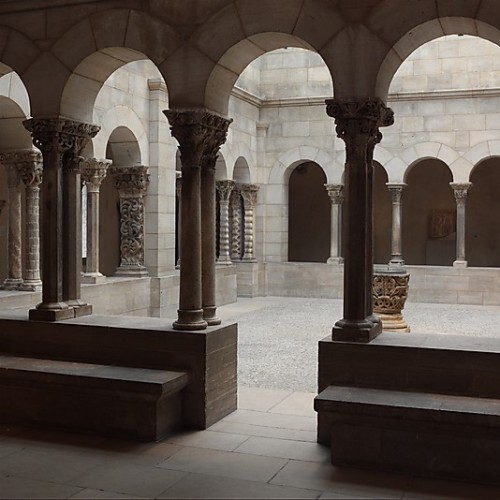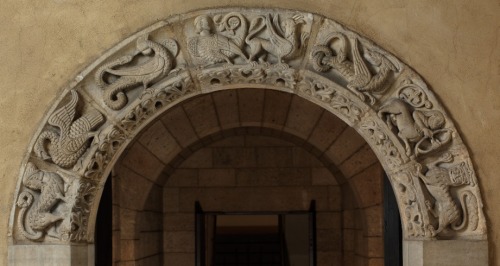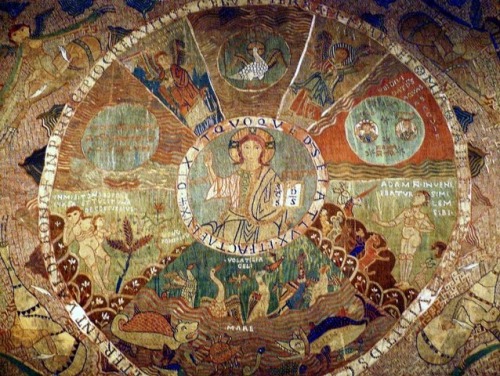#12th c
Portal from the Abbey Church of Saint-Laurent
From near Cosne-Cours-sur-Loire, central France
1120-50 CE
“This imposing portal originally served as the main entrance to the small Augustinian abbey church of Saint-Laurent in central France, on one of the pilgrimage roads to the shrine of Santiago de Compostela in Spain. It displays bold abstract patterns on round arches and capitals with complicated intertwined branches, leaves, and birds characteristic of Romanesque architecture. The style seen here was inspired by that of the most influential Benedictine monastery in Europe, Cluny, which had founded the large church of La Charité-sur-Loire near Saint-Laurent. At the suggestion of George Grey Barnard, sculptor and collector of medieval architecture and sculpture, when the portal was installed in the Museum two smaller doorways were added on either side following a design popular in the region of Saint-Laurent, although the origin of these doors remains undetermined. In the Museum the portal now faces a group of large Romanesque capitals, of which six are known to have come from the interior of the church of Saint-Laurent. (Dean Walker, from Philadelphia Museum of Art: Handbook of the Collections (1995), p. 111.)”
Currently in the collection of the Philadelphia Museum of Art. Image and description taken from the Philadelphia Museum of Art’s website, which includes additional images of the doorway.
Post link
Capital with Demons Punishing the Sins of Avarice and Blasphemy
Made in southern France
1175-1200
Currently in the collection of the Philadelphia Museum of Art (Purchased with Museum funds from the George Grey Barnard Collection, 1945). Image taken from the Philadelphia Museum of Art’s website.
Post link
Cloister from Saint-Guilhem-le-Désert
French
Late 12th c.
Limestone
‘Situated in a valley near Montpellier in southern France, the Benedictine abbey of Saint-Guilhem-le-Désert was founded in 804 by Guilhem (Guillaume) au Court-Nez, duke of Aquitaine and a member of Charlemagne’s court. By the twelfth century, the abbey had been named in honor of its founder and had become an important site on one of the pilgrimage roads that ran through France to the holy shrine of Santiago de Compostela in Spain. With the steady visits of travelers en route to the shrine and the gifts they brought with them, a period of prosperity came to the monastery. By 1206 a new, two-story cloister had been built at Saint-Guilhem, incorporating the columns and pilasters from the upper gallery seen here. Most of these columns are medieval versions of the classical Corinthian column, based on the spiny leaf of the acanthus. This floral ornamentation is treated in a variety of ways. Naturalistic acanthus, with clustered blossoms and precise detailing, is juxtaposed with decoration in low, flat relief, swirling vine forms, and even the conventionalized bark of palm trees. Among the most beautiful capitals are those embellished by drill holes, sometimes in an intricate honeycomb pattern. Like the adaptation of the acanthus-leaf decoration, this prolific use of the drill must have been inspired by the remains of Roman sculpture readily available in southern France at the time. The drilled dark areas contrast with the cream-colored limestone and give the foliage a crisp lacy look that is elegant and sophisticated.
Like other French monasteries, Saint-Guilhem suffered greatly in the religious wars following the Reformation and during the French Revolution, when it was sold to a stonemason. The damages were so severe that there is now no way of determining the original dimensions of the cloister or the number and sequence of its columns. Those collected here served in the nineteenth century as grape-arbor supports and ornaments in the garden of a justice of the peace in nearby Aniane. They were purchased by the American sculptor George Grey Barnard before the First World War and brought to this country. A portion of the original cloister remains at Saint-Guilhem.’
The cloister is in the collection of The Cloisters, The Metropolitan Museum of Art. Description and image taken from the Met’s website. You can see more photos of the cloister here on their site.
(**Tour 4/5)
Post link
Capitals from the Cloister from Saint-Michel-de-Cuxa
Catalan
circa 1130-40
Marble
‘The Benedictine monastery of Saint-Michel-de-Cuxa, located at the foot of Mount Canigou in the northeast Pyrenees, was founded in 878. In 1791, Cuxa’s monks departed in the wake of the French Revolution, and much of the monastery’s stonework was subsequently dispersed. The monastery’s cloister, built during the twelfth century, originally measured some 156 by 128 feet, or approximately twice its current size at The Cloisters, much of whose architecture is modern. Like the ensemble from Saint-Guilhem, elements were purchased by George Grey Barnard and brought to the United States; part of the cloister survives at the monastery which, once again, houses a community of monks.
The cloister was the heart of a monastery. By definition, it consists of a covered walkway surrounding a large open courtyard, with access to all other monastic buildings. Usually attached to the southern flank of the church, a cloister was at the same time passageway and processional walkway, a place for meditation and for reading aloud. At once serene and bustling, the cloister was also the site where the monks washed their clothes and themselves.
The warm beauty of the native pink marble used at Cuxa harmonizes this cloister’s many elements, such as the varied capital sculptures carved during different periods in its construction. Some of these are fashioned in the simplest of block forms, while others are intricately carved with scrolling leaves, pinecones, animals with two bodies and a common head (a special breed for the corners of capitals), lions devouring people or their own forelegs, or a mermaid holding her tail. While many of these motifs may derive from popular fables or depict the struggle between the forces of good and evil, the conveyance of meaning seems to have been less important for the Cuxa artists than the creation of powerful works capturing the energy and tension between the forms depicted.’
Description and image taken from the Met’s website. You can see more photos of the cloister here on their site.
(**Tour 3/5)
Post link
Narbonne Arch
French
circa 1150-75
Marble
‘This semicircular arch comprises seven stone blocks (known as voussoirs) decorated with eight real and fantastic animals: left to right, a manticore (“man-eater” in Persian, with the face of a man, the body of a lion, and the tail of a scorpion); a pelican (symbol of Christ); a basilisk (dragon with a serpent’s tail, signifying the power to kill); a harpy (half- woman, half-bird creature whose sweet song lures men to their deaths); a griffin (with the body of a lion and the head and wings of an eagle); an amphisbaena (serpent with a head at either end); a centaur (with the head and torso of a man and lower body of a horse); and a crowned lion. These are all animals familiar from medieval bestiaries: texts compiled in the twelfth century describing such creatures and explaining their moral and religious associations.
The closest parallel to the carving style of the arch can be found in the nave capitals of the mid-twelfth-century church of Saint-Paul-Serge in Narbonne, but the original location of the arch remains unknown.’
The arch is in the collection of The Cloisters, The Metropolitan Museum of Art. Image and description taken from the Met’s website.
(**Tour 2/5, see this post for more information)
Post link
Workshop of Master Biduino (Italian, active last quarter of the 12th c.)
Doorway from the Church of San Leonardo al Frigido
circa 1175
Carrara marble and re-used antique sarcophagus
‘Dedicated to Saint Leonard, the patron saint of prisoners, this portal served as the main entrance of the small Church of San Leonardo al Frigido. An antique sarcophagus was reused for the supporting jambs on the sides of the door; it was carved to show scenes of the Annunciation and the Visitation on the left and an image of Saint Leonard holding an emblematic prisoner on the right. The Entry into Jerusalem on the lintel is modeled after an Early Christian tomb relief. The doorway is a product of the workshop of Master Biduino, who worked in the Pisa-Lucca area.’
The doorway is in the collection of The Cloisters, The Metropolitan Museum of Art. Description and images taken from the Met’s website. You can see more images of the doorway (with zoom ability) here on their site.
**As a side note, this was one of the five works at The Cloisters I spent last summer developing a public gallery tour around. I’ll be posting the other four works soon so you can go on a virtual version of my tour if you’d like. My tour focused on architectural sculpture at The Cloisters. I hope you like it!
(1/5)
Post link
Creation Tapestry, c. 1100. Embroidered in wool and linen on a wool background, 12’ x 15’ 8". Currently in the Gerona Cathedral Treasury in Spain. Source.
“In Gerona, the Creation Tapestry, made with linen thread against a wool background, depicts a beardless Christ as Pantocrator in the center of a compositional wheel, filled with scenes from Genesis, including the Days of Creation, the Creation of Eve, and Adam Naming the Animals. In the corners, symbols of the four winds turn the wheel, suggesting the movement of the days. On three sides, marginal representations of the labors of the months and emblems of the annum and solstices continue to convey the passage of time. Curiously, in the bottom margin, the legend of the Discovery of the True Cross is shown. Although it is not certain where or how the tapestry was originally displayed, its complex iconography reveals a belief in the enduring lordship of Christ from the beginning to the end of Creation.” (Snyder, Art of the Middle Ages, 258)
Click here to see a larger image of the tapestry.
Post link
Bifolio illustrating a scene from Revelation 12- including the woman clothed in the sun (upper left), the multi-headed dragon who pulled down a third of the stars from heaven (center), and Satan bound in hell (bottom right)- from the Silos Beatus, c. 1091-1109. Image taken from ARTstor.
Post link
Folio depicting the adoration of Christ enthroned and the lifting up of St. John from the Spanish Silos Beatus, c. 1091-1109. Image taken from ARTstor.
Post link










